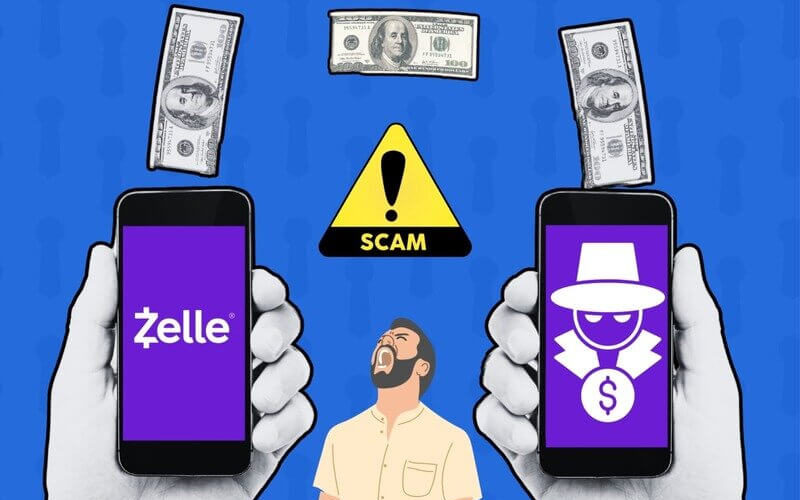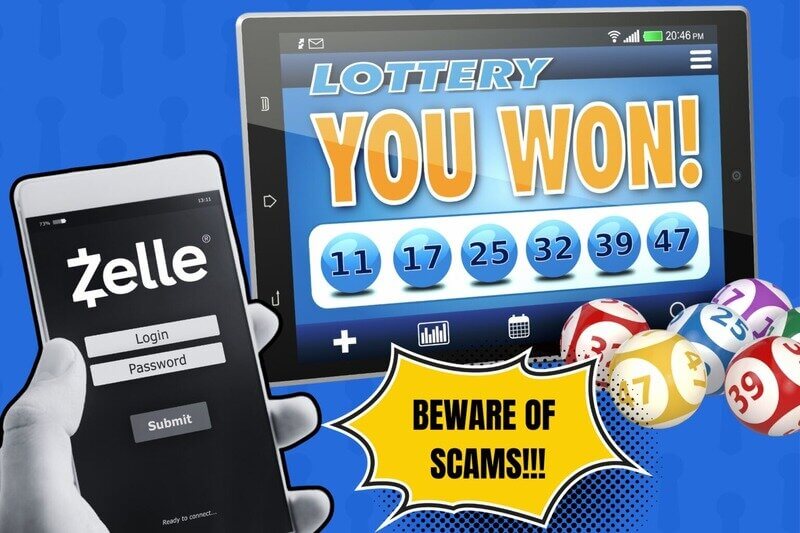15 Common Zelle Scams And How To Avoid Them (2024)

I remember the days before peer-to-peer payment services.
Most of the time, credit and debit worked fine. But there were times when you just needed to hand cash to a friend. Sometimes, we’d have someone come to the house to do work, and paper checks were the only option unless we happened to have hundreds of dollars in cash on hand.
We never do!
Now, thanks to apps like Zelle and Venmo, we can send cash to anyone we need. I use these apps to send money to colleagues collecting flowers for a peer. Sometimes, my stepdaughter needs a little extra cash. Zelle is great for that. And I’ve used Venmo to pay service providers who don’t want to pay credit card fees.
Unfortunately, though, that convenience comes at a price. The more popular these apps become, the more they (or rather the people using them) are targets for scammers looking for a new way to make money.
And few apps have grown in popularity like Zelle.
In fact, the app is the second most popular peer-to-peer payment app among U.S. adults. The first place is Venmo.
Like other payment platforms, though, Zelle has had its fair share of scams in recent years. Does that mean we should stop using them? No. But being aware of those scams can help us stay safe.
Let’s look at the most common Zelle scams and how you can keep your money safe.
What are Zelle Scams?
Zelle is a peer-to-peer payment system that lets you send and receive money electronically. With a few taps on the screen, you can move funds from your account to someone else’s without entering account numbers or credit card information.
Yet one thing that sets Zelle apart is that it’s bank-oriented. When I log into my bank account and look for payment options, “Send Money with Zelle” is one of the options.
Here’s how it works:
As with other payment apps, Zelle takes precautions to keep members safe. However, scammers have managed to find ways to work the system. Whether it’s a security breach or someone tricking you out of your money, it’s important to know the risks so you can avoid them.
15 Common Zelle Scams

Account fraud is an ongoing issue with payment apps, and Zelle is no exception. Here are some of the most common scams affecting Zelle users today:
- Account Takeover Fraud
- Phone Scams
- Spoofing and Phishing Scams
- Malware Scams
- Job Scams
- Invoicing Scams
- Overpayment Scams
- Reverse Payment Scams
- Upgrade Scams
- Online Selling Scams
- Rental Scams
- Romance Scams
- Imposter Scams
- Lottery Scams
1. Account Takeover Fraud
What Is It?: Someone accesses your account without your permission and locks you out. You don’t even need to use your Zelle account for this scam to affect you. Since Zelle operates through popular banks, it can become a target for cybercriminals.
How to Spot It: Typically, you’ll know there’s an issue with your account when you try and fail to log in. In some cases, you may find your account is locked. Financial institutions will often lock Zelle if suspicious activity is detected to minimize losses.
How to Avoid It: Criminals can hack your account even if you take all precautions. However, setting a strong password, guarding your account information carefully, and refraining from clicking links in emails can reduce your risk. Zelle recommends setting up multifactor authentication through your bank, as well as all other services you use to support your Zelle payments.
2. Phone Scams
What Is It?: You answer the phone to someone claiming to be a bank representative. Your Caller ID may show the caller as your bank, and these scammers may even know details about your account. The goal is to steal your money.
How to Spot It: In most cases, scammers will tell you there’s a fraudulent charge on your account and to reverse it, you need to send money to a separate account. Any call asking for account details or directing you to send money to an unfamiliar account should be eyed with suspicion.
How to Avoid It: Never send money to a person you can’t verify. If you get a call claiming to be from a financial institution or payment app, hang up and contact your bank to check on your account.
3. Spoofing and Phishing Scams
What Is It?: With spoofing and phishing schemes, a fraudster poses as someone else to contact you via phone or email. Technology makes it easy to fake contact information on Caller ID or in email, so even when a contact looks like it comes from an authentic source, it can be fraudulent. The goal is to separate you from your personal information.
How to Spot It: There is no way to detect a spoofed phone call, so it’s important to avoid giving information or taking action based on a call. Email addresses are equally easily spoofed, but you can often tell an email isn’t legitimate based on elements like typos and font inconsistencies.
How to Avoid It: No matter how legitimate a phone call or email looks, always go directly to the source when you receive an alert. Never click on links or provide information to someone who has contacted you.
4. Malware Scams
What Is It?: When you click on a link, in some instances gathering account information isn’t the only goal. Sometimes clicking on those links downloads malicious software to your device. Known as malware, some versions can steal your login information.
How to Spot It: Although often malware operates quietly in the background, there can be some telltale signs. Malware is notorious for slowing down devices and causing unexplained glitches. If your data consumption suddenly spikes, that’s a sign you might have malware running in the background.
How to Avoid It: The first step in preventing malware is to avoid clicking on any suspicious links. You can add another layer of protection by installing antivirus software on all your devices. If you suspect your device has been infected, avoid banking apps and activities that require passwords until you can remove them.
5. Job Scams
What Is It?: When we’re looking for employment, job boards are often the first stop. With Zelle job scams, fraudsters post legitimate-looking job ads, promising an impressive salary and benefits for the experience level. You’ll jump through the hiring hoops, and then be asked to pay a fee for onboarding expenses.
How to Spot It: A legitimate employer should not ask for payment in exchange for employment. Any request for funds should be eyed suspiciously.
How to Avoid It: Carefully vet any potential employment opportunity before providing any sensitive information or transferring funds.
✎ Related: Work-from-Home Scams – Learn and Protect Yourself ➔
6. Invoicing Scams
What Is It?: With an invoicing scam, you receive a text or email that claims you owe money. The message then invites you to click on a link to view the invoice. The message may even appear to be from one of your vendors, customers, or clients.
How to Spot It: These emails can appear legitimate on the surface, but chances are, they don’t match the way you pay this particular business or individual. Even if they do, when you click over, the interface of the payment app will be off.
How to Avoid It: Avoid clicking on links in messages, even if you’re expecting an invoice. If you have questions, reach out to your contact via your usual methods to verify the invoice.
7. Overpayment Scams
What Is It?: In overpayment scams, scammers send an unsolicited large sum and ask for a refund via Zelle. The initial payment is often fraudulent, leading victims to lose their own money when it’s reversed. This scam targets Zelle users, where a check for an item exceeds the agreed price, and the victim is asked to send the excess electronically.
How to Spot It: Checks have long been prone to fraud. If someone wants to pay that way, it can immediately be a red flag. If they’ve overpaid, there’s double reason for concern.
How to Avoid It: Make it a policy to only accept cash or electronic payments when selling to strangers. If you do have to accept a check, insist it be written for the agreed-upon amount, and never refund an overpayment.
8. Reverse Payment Scams
What Is It?: You get a phone call from someone claiming to be a bank representative. You’re alerted you were scammed, but you can fix the problem by simply reversing the transfer. In some cases, the caller will even know the exact amount. When you reverse the funds to your account, they’re stolen.
How to Spot It: Bank representatives won’t ask you to reverse funds in response to fraud. If someone calls you out of the blue about your Zelle account, it should always be viewed with suspicion.
How to Avoid It: If you receive a call from someone claiming to be from your bank, hang up and contact your branch directly. They should be able to help you if fraud has, indeed, impacted your account.
9. Upgrade Scams
What Is It?: Online sellers have reported a scam where someone claims to have sent you money for a product you’re selling. The buyer first asks if they can pay with Zelle, and when you say yes, you’re directed to an email that supposedly confirms the payment. The email informs you that to get the money, you’ll need to upgrade to a business account.
How to Spot It: These messages tend to use urgent wording to get you to click. You’ll see wording like, “account on hold” and “take urgent action.” They also claim you’ll need to submit fees to qualify for this higher-tier account that lets you accept the funds.
How to Avoid It: If there’s an issue with your Zelle account, it will be reflected when you log into the app. Instead of clicking on links in the message, log into your account and look for alerts there.
10. Online Selling Scams

Photo by Facebook
What Is It?: Platforms like Facebook Marketplace have become popular for buying items locally. You can often find yourself competing with other interested buyers for the same item. Knowing this, scammers create urgency to encourage people to pay quickly without asking too many questions.
How to Spot It: If a seller is demanding payment to hold an item, it should serve as a red flag.
How to Avoid It: If you’re buying an item locally, insist on meeting the seller in person in a public, well-lit, heavily trafficked location. Don’t pay for the product until you’ve seen it and are ready to walk away with it. If you sense, at any point, something isn’t right, listen to your instincts.

11. Rental Scams
What Is It?: Whether it’s a vacation condo or you’re renting month to month, it can be tough to find a good price on a rental home. Knowing Zelle charges aren’t reversible can make it easy for fraudsters to advertise a fake rental, and then disappear once the funds have been transferred.
How to Spot It: Rental listings should have multiple pictures of the property, both inside and out. If it’s a local property, a landlord should be open to giving you a tour of the interior. For vacation rentals, a lack of reviews can be a warning sign someone is scamming.
How to Avoid It: Insist on seeing the property in person whenever possible. For vacation rentals, check out the address on Google Street View before making any deposits. Reputable rental owners should have at least a few reviews. If a property is new to the platform, look up the owner’s other properties to find reviews.
✎ Related: Rental Car Scams – What They Are And How To Avoid Them ➔
13. Romance Scams
What Is It?: You’ve probably heard of being “catfished.” With catfishing, someone poses as someone else online. If catfishing has taught us anything, it’s that you don’t always know who’s on the other side of that computer screen. With Zelle romance scams, fraudsters use online dating and social media platforms to win your trust, then use that trust to convince you to send money or hand over account details.
How to Spot It: If you haven’t met someone in person and they want you to send money, it’s likely a sign of fraud.
How to Avoid It: You’ll probably want to avoid romance scams altogether, but from a financial standpoint, it’s important to keep your bank account out of new relationships. Even if you’ve met someone in person, be wary of any requests for money or account logins and passwords.
✎ Related: Tips for Protecting Yourself Online ➔
14. Imposter Scams
What Is It?: Thanks to social media, it’s fairly easy to get information on someone’s friends and relatives. With imposter scams, the fraudster reaches out, claiming to be someone you know. The person will cite some sort of emergency, and then ask for you to forward funds.
How to Spot It: Someone you haven’t spoken to in a while reaches out, asking for money. There’s an urgency behind the request, designed to encourage you to click without asking questions.
How to Avoid It: If you get a sudden request for funds, disengage from the communication and track down the person who supposedly needs help. If you can’t get in touch through a channel you know is legit, block the person asking for the funds.
15. Lottery Scams
What Is It?: “Congratulations! You’re a winner.” Who wouldn’t want to hear those words? Unfortunately, these communications are all too often scams. These fraudsters can operate through email, text, phone, or even social media. The goal is to convince you to click on a link to claim your prize, where you’ll enter Zelle account details.
How to Spot It: If you actually win a prize, you shouldn’t have to provide account details to claim it. In fact, take care when even clicking on links in these sorts of messages.
How to Avoid It: Never provide your bank account or login credentials to claim a prize.
✎ Related: Sweepstakes and Lottery Scams ➔
Can Someone Hack Your Zelle with Your Phone Number?
Where there’s a will, there’s a way.
And hackers definitely have a will.
So, did you know that a hacker can access your Zelle account using only your phone number?
This is scary for one reason: Phone numbers are easy to get. You’ve probably given yours out to someone recently.
Zelle is connected to your bank account, so if someone knows who you bank with and your phone number, it could be a recipe for fraud.
It would be up to your bank’s security to catch it. And security protocols vary between banks. See the problem?
There’s a well-known scam where criminals use your bank information and phone number combination to trick you into handing over control of your account. It can happen quickly, and using this technique, a thief can empty out your bank account in mere minutes.
Here’s how this scam works:
So, yes, a hacker can use your phone number to hack their way into your bank account, set up Zelle, and transfer all YOUR money away.
Your phone number can also be used for another common form of Zelle fraud: Phishing.
If a scammer is clever enough, a legitimate-looking text to your phone could trick you into providing your banking username and password. That information gives a thief direct access to your bank account, with no Zelle required.
How to Avoid Zelle Scam?
How did we live before peer-to-peer payment apps like Zelle? I’m not sure.
While they’ve made life so much easier, they also come with some drawbacks. We’re more vulnerable to fraud now that we can access our bank accounts with just a username and password.
We don’t have to give up all that convenience to stay safe. Here are some steps that can help keep fraudsters on the other side of that security gate.
1. Never Click on Suspicious Links
I don’t even remember the first time I clicked on an internet link. Somewhere in those early years, though, it became second nature. If you see underlined blue text, you know to click.
Today, we don’t even need the underline. A link can be in the same color as the text surrounding it, with no underline whatsoever.
That compulsion to take action, though, is how so many have been scammed. An urgent enough message will have your fingers itching to click on those words.
Don’t do it!
Whether the message says you’ve won money, your account has been locked, or your invoice is attached, always eye links in messages suspiciously. Stop and go to a web browser, then pull up the website in question and look for account issues.
2. Never Send Money to Yourself
Why would you send money to yourself? It’s simply a way to transfer funds from one bank to another.
But in order to send money to yourself in Zelle, you’ll have to set up a login for a completely separate bank where you have an account. Zelle will need a different email address or phone number, and you’ll have to be verified through Zelle’s usual process. You can’t send money from an account to the same account.
If someone is telling you to “reverse an unauthorized transaction” by sending money to yourself in Zelle, they’re hoping you don’t know this easily missed rule. It’s a sure sign they’re scamming you.
3. Keep Your Account Secure
All your banking apps should be locked down as much as possible. This will help prevent someone from accessing your account without your approval. Here are some tips for safeguarding your Zelle account.
Use Strong Passwords
Passwords should be:
- Easy to guess
- The same across all your accounts
- Complex and tough to guess
If you picked the last option, you’re correct! As inconvenient as it may be, longer, more complex passwords keep your account safer. For your online banking accounts, in particular, complex passwords are best.
What’s a complex password? A good password has at least 15 characters and is a combination of numbers, letters, and special characters. Don’t include your name, your business name, or anything else that would help fraudsters guess it.
If you have trouble keeping up with all your logins, consider a password manager like LastPass or 1Password.
Enable Multifactor Authentication
I use Zelle through my banking app, so this isn’t an option. Yet I do have multifactor authentication set up on my bank account.
If you use Zelle directly, you can choose multifactor authentication in its settings.
With multifactor authentication, you’ll be asked to verify it’s you through a secondary source every time you log into Zelle from an unfamiliar app. If someone tries to log in as you, they won’t be able to pass the login screen without having that second form of contact.
Best of all, if someone tries to log in as you, you’ll see the request for authentication on your secondary contact method. This is usually a code texted to your mobile device.
Don’t Share Login Information
No matter what app you use, you should guard your login information. This is especially important with banking apps.
Sure, you only share your information with someone you trust. Yet that’s one more device that holds your username and password. And that’s one more device that hackers can infiltrate.
4. Don’t Pay Strangers
We were told as children not to talk to strangers.
There was a reason for that. While many strangers have honorable intentions, there are people who are up to no good.
That advice applies to paying strangers.
Yes, you can find great deals online since you’re buying from a person rather than a business that takes a cut. This also means you don’t have an intermediary to absorb the risks.
Zelle can be a convenient way to pay people you know. But when it comes to paying complete strangers, it’s not the best.
The reason for that is simple. Zelle lacks the built-in protection that you find with apps like Venmo and PayPal. As long as you tag a payment as a purchase, Venmo’s Purchase Protection has you covered. PayPal gives you buyer protection as long as you don’t mark the purchase as Friends and Family.
Even your credit card offers some purchase protection.
Basically, Zelle ranks slightly below cash as the riskiest way to pay someone.
5. Confirm Contact Information
It’s your responsibility to make sure you’re sending a payment to the right person. If it ends up in the wrong account, you may not be able to get your money back.
Before hitting the Send button, double and triple-check the contact information. If you aren’t sure of a recipient’s email address or phone number, reach out to verify it before you complete the transaction.
6. Avoid Using Public Wi-Fi
You likely have done what it takes to keep your home Wi-Fi secure. That helps safeguard your information when you’re managing your finances.
But Zelle is designed to be used on the go, through the convenient mobile app.
The problem with that is that once you leave home, you lose that security. The Wi-Fi you use at your local coffee shop or while staying at a hotel may not be secure at all. And that can invite hackers.
If possible, wait until you’re on your home’s Wi-Fi to log into Zelle.
✎ Read Full: Avoid Using Public Wi-Fi ➔
6. Monitor Your Accounts
Whether you have reason to believe you’ve been scammed or not, it’s important to keep an eye on your bank accounts. Look for signs of unusual activity and take action as soon as possible if you see something.
Fraud alerts can be a great way to stay on top of your accounts. Your bank should have this feature built into its app.
Identity theft protection, such as that provided by Aura, is another way to protect your finances. You’ll be alerted as soon as possible if your identity has been compromised so that you can prevent further damage.
What to Do if You’ve Been Scammed on Zelle?
What happens if, despite all your protections, you fall victim to a scam? Here are some steps to take next.
1. Communicate with the Seller
In cases where a seller has defrauded you, the best first step is to make an attempt to resolve it with that person. This is the easiest route. Even if the seller won’t refund your money, you’ll have a record that you tried to straighten things out.
Be sure you save all communication so that you can present it during the dispute process.
2. Try to Cancel the Payment
You can’t cancel a Zelle payment once it’s on its way.
There’s one exception to that.
If the seller hasn’t yet enrolled with Zelle, you may be able to cancel the payment. Find the transaction under your activity and click Cancel This Payment next to the transaction.
It’s a small chance, but it’s worth a try.
3. Report the Transaction
Whether you can get your money back or not, you should report the transaction. The fraudulent seller needs to be investigated and potentially flagged to prevent future fraud.
Zelle has a form you can use to report fraud through the app. If you made the purchase through your bank’s Zelle feature, you should report it to your bank.
You can also report the fraudster to the FBI through the Internet Crime Complaint Center.
4. Request a Chargeback
If you use a credit card to make a purchase, you can often dispute it. However, with electronic transactions, chargebacks typically aren’t an option. Still, it’s worth checking with your bank to make sure there’s no recourse.
5. Block the Seller
Chances are, you plan to continue to use Zelle, even after you’ve been scammed. To keep the service safe, block the fraudulent user to ensure they can’t defraud you again. Under Settings, click Block or Unblock Requests. Fill in the information, then choose Block.
6. Consider Identity Theft Protection
The identity theft protection can keep your credit safe. If you have been a victim of fraud, it will give you that extra layer of safety you need. With identity theft protection, you’ll be notified if someone applies for credit in your name. You can then lock your credit and stop the activity in its tracks.
Some identity theft services can monitor your bank accounts, which will be a big help when using Zelle inside your banking app. This can help you move forward with confidence as you use peer-to-peer payment services.
Zelle is a useful app that can make transferring funds a breeze. It can also put your money at risk. As long as you take extra precautions, you’ll be able to enjoy the convenience while also being able to sleep at night.
✎ Scams Related to Peer-to-Peer Payment Apps ➔



